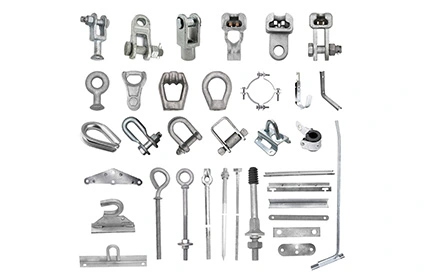There are 5 steps for the installation of overhead power line accessories:
Preparation and Planning: Conduct a comprehensive site assessment of china's overhead line fittings considering terrain, weather, and load requirements.
Assembly and Inspection: Assemble these hardware fittings for transmission lines according to manufacturer guidelines, ensuring all bolts and connections like D iron clamp are securely tightened.
Lifting and Attachment: Lift and position assembled these electric power fittings onto poles or towers, using appropriate lifting equipment.
Alignment and Tensioning: Proper alignment and tensioning are crucial for the safe and efficient operation of overhead power line fittings in China.
Final Checks and Documentation: Conduct thorough quality checks of china's overhead line fittings, addressing any issues identified during the inspection.

The overhead line equipment components, a crucial element in power transmission and distribution, consist of a well-coordinated system of essential elements designed to efficiently transport electrical energy from generation sources to end-users. At its core, an overhead line typically comprises conductors, supporting structures, insulators, and associated overhead line hardware. Among these components, the eye bolt electrical service plays a pivotal role in securing and supporting various elements, ensuring the stability and reliability of the overhead line system.
Conductors form the backbone of the overhead line, serving as the pathway for electricity to flow. These conductors including ball eye link are often made of aluminum or copper, chosen for their excellent conductivity and durability.
Supporting structures, such as poles or towers, play a critical role in elevating the conductors above the ground and maintaining the required clearance. The design and placement of these structures are essential to ensure the stability and reliability of the overhead line.
Power line insulators, often made of ceramic or composite materials, are strategically placed to electrically isolate the conductors from the supporting structures, preventing unintended paths for current flow. This is crucial for maintaining the integrity and safety of the system .
Additionally, associated hardware such as clamps, connectors, and pole line hardware fittings are employed to secure and connect various components of the overhead line, ensuring a robust and reliable transmission network.

Overhead power line fittings in China are essential components for power transmission and distribution systems. China overhead power line fittings manufacturers/suppliers produce high-quality electrical overhead line equipment components that meet international standards. Partnering with trusted manufacturers of overhead power line accessories ensures access to industry-leading products and services.
The quality of electrical overhead line equipment components is critical to the safety and efficiency of power transmission systems. Leading China overhead power line fittings manufacturers/suppliers adhere to strict quality control measures. From raw material selection to final product testing, every step of the production process ensures the reliability of electrical overhead line equipment components. With a strong commitment to quality, suppliers of electrical overhead power line fittings in China have earned the trust of global utility companies.
China overhead power line fittings manufacturers/suppliers are favored by power companies worldwide. Overhead power line fittings in China are designed to endure extreme weather conditions. Overhead power line accessories meet the highest standards for safety, durability, and performance. By choosing China overhead power line fittings, buyers benefit from competitive pricing and customized solutions.


If You Have Any Questions or Suggestions About Line Equipment, Let Us Know, We Will Reply As Soon As Possible.